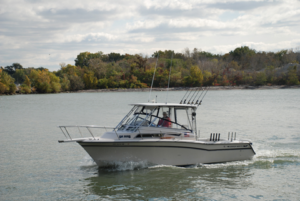Blog
Tagged In: algae bloom, Clean Water, Lake Erie, small business, toledo, toledo water crisis, toxic algae
The Bottom Line for Business: We Can No Longer Have No Response to the Toxic Algae Blooms in Lake Erie
Dave Spangler, Lake Erie Charter Boat Captain, June 5, 2018

Since 2003, Lake Erie has experienced increasingly intense harmful algae blooms. Only two of the past 15 years have had acceptable algal bloom levels.
In 2011, the majority of the western basin was covered with microcystis, the blue-green bacteria that makes up the bloom. The bloom eventually reached the Cleveland area and was listed as the largest bloom ever. Real estate sales slowed, values flatlined and the community still has not recovered.
Then, in 2012, we saw a complete reversal with very little algae anywhere in the Lake. There were no major rain events and in fact, the year was listed as a drought, highlighting that the problem was primarily coming from rain washing away chemical fertilizer and manure used by agricultural producers.
By 2013, the Water Treatment Facility in Carroll Township in Ottawa County issued a “do not drink” order for all of the residents supplied by this facility. The algal bloom was surrounding the water intake and the toxin level (microcystin) was beyond the capability of the facility to correct the issue. This was a first for Ohio, but did not get a lot of attention as the Township served just around 2,000 people.
The community in Carroll had absolutely nothing to do with the bloom, but got a 4% tax increase the following year to build a new ozone treatment system so we could have drinkable water. The cost was one-third of the entire annual budget. I was very upset about this and wondered how something like this could happen to a community that didn’t cause the bloom.
Then in 2014, the Toledo Water Crisis made international news. Over 400,000 people were told that they could not drink their water and they scrambled to get bottled water from anywhere they could. As in the Carroll Township event, all of those people in Toledo and the surrounding area had absolutely nothing to do with the large bloom that poisoned the water. Yet, ever since, these folks have been paying for it with tax rate increases of 13% or more to cover added chemicals and equipment to deal with the toxin. Unfortunately the legislation passed did not go far enough to reduce the severity of the algal blooms.
In 2015, the former largest bloom on record was shattered. Starting in mid-July, the extent and intensity of the bloom covered shore to shore in the western basin and continued well into October. The charter boat business and most fish-related businesses took at least a 25% hit that year. To a business that only operates seven months out of the year this loss is detrimental. A business simply cannot recover with that kind of hit on the bottom line.

Nature must have noticed that we did not get the message in 2012 because in 2016, we had very little rain and consequently, very, very small blooms. The nearly absent blooms in 2012 and 2016 verified that point sources are NOT the main problem and we learned that 85-87% of the runoff comes from the land.
2017 ended up being the third largest bloom on record with the majority of the western basin covered. The bloom even backed up into the Maumee River.
In early October, I could run from Wild Wings Marina all the way to Lemington, Ontario, and not get out of the bloom. I did not run a single charter trip last year. This had a huge impact on my bank account.
This year there have been multiple heavy rain events leading to toxic algal blooms across the Lake Erie basin, earlier than has ever been witnessed before.
During the last seven years, there have been no appreciable reductions in the bloom coverage or intensity. In fact, the volume of dissolved reactive phosphorus, a main algae-causing chemical, has increased every year.
Until the dissolved reactive phosphorus (DRP) and total phosphorus (TP) are substantially lowered by at least 40%, we will never improve this situation and our businesses will continue to take the hit. Businesses that rely on the lake need immediate action from state government before it’s too late for us.
